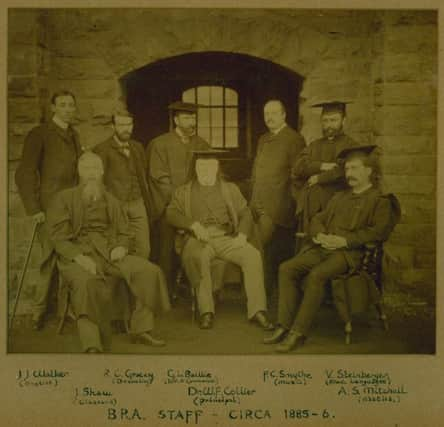Roamer: Disturbing story from a hundred years ago resonates disquietingly today


Archives showed that Steinberger taught modern languages in the school between 1880 and 1886.
Former Academy teacher, author and archivist Edward McCamley, with former pupil Sandra Ardis of the North of Ireland Family History Society, discovered a poignant story headlined ‘A Life Less Ordinary’ by Mr McCamley, whose account encapsulates “many elements as disquieting today as they were in the first great phase of globalization before the WWI.”
Advertisement
Hide AdAdvertisement
Hide AdThe rest of Roamer’s page today is ‘A Life Less Ordinary’, reproduced predominantly from the Academy’s website with grateful thanks to both Edward and Sandra.
Valentine Steinberger, a Munich University graduate, taught briefly in Europe before a snippet in the Belfast News Letter on May 27, 1879 indicated that he’d settled here and was teaching in St Malachy’s College, Belfast, and was a part-time teacher in Bangor Endowed School.
He married Eliza (Elizabeth) Ferris from Coleraine in October 1880 and a year later daughter Cecilia was born.
Following part-time studies Valentine received an Honours degree in German and became a modern languages teacher in Belfast Royal Academy.
Advertisement
Hide AdAdvertisement
Hide AdSon Charles was born to the Steinbergers, like his sister, in Coleraine. During the week Valentine lived in Cliftonville Avenue, taught in the Academy and acquired two additional degrees in modern languages.
In 1886 he resigned from the Academy, whose pupils presented him with a silver inkstand and a gold pencil.
The Steinbergers moved to Galway when Valentine became Professor of Modern Languages in what was then Queen’s College, Galway.
Another son, Fritz Robert, was born in 1888, and then another girl, Lillian Blanche.
In June 1913 Valentine became a British citizen.
Advertisement
Hide AdAdvertisement
Hide AdThe apparently happy and successful life of Professor Steinberger continued.
However, in August 1914 the First World War began, and two years later in April 1916 the Easter Rising in Dublin dramatically affected the Steinbergers in a way that they could never have anticipated.
Just before the Rising there had been an attempt to smuggle guns from Germany to Ireland; Roger Casement, an Irish nationalist leader, had landed on the coast of Kerry from a German submarine; Patrick Pearse, leader of the Dublin rebels, spoke of the Germans as ‘our gallant allies in Europe’.
There had been action in support of the rebels in Galway, and when the Rising was finally suppressed 15 of those deemed responsible for it were executed.
Advertisement
Hide AdAdvertisement
Hide AdMartial Law was proclaimed throughout Ireland and 3,430 men were arrested.
Valentine Steinberger, being German by birth, was one of those arrested.
When the number of prisoners threatened to overwhelm the military prison system, Steinberger and others were held in various Royal Navy ships.
They were then detained for a time in Wandsworth Prison in London before being sent back to Richmond barracks in Dublin.
Advertisement
Hide AdAdvertisement
Hide AdConditions were often extremely grim, and on his release, Steinberger’s health had deteriorated.
He died on November 3, 1916.
His only known involvement in Irish politics had been his attendance at a meeting in Portrush Town hall in 1896, opposing plans for a fenced boundary at the Giant’s Causeway where visitors would be charged an entrance fee!
He was a law abiding citizen; Sandra Ardis even found records of his payments for a dog licence! In 1911 and 1912 he paid 2 shillings and 6 pence for a licence for a red and tan Yorkshire Terrier. In 1914 the licence was for a grey Terrier.
After her husband’s death Eliza Steinberger returned to Coleraine where she died in 1934.
Advertisement
Hide AdAdvertisement
Hide AdDaughter Cecilia, reputedly the first Catholic girl to graduate from Trinity College Dublin, moved to England where she later married.
Daughter Lillian Blanche emigrated from Ireland to Canada in 1910, where she eventually married Sergeant Percival Bate of the Victoria Fusiliers.
Her brother Fritz Robert also went to Canada.
Charles became a seaman.
Valentine Steinberger’s life encapsulates many elements as disquieting today as they were in the first great phase of globalization before the WWI.
The scholarly figure in mortar board and gown photographed with other masters in his last year at the Academy had moved about Europe before finding congenial work in the school, and then in Galway.
Advertisement
Hide AdAdvertisement
Hide AdHe married a local girl, supported his growing family, and became a citizen of his adopted country - he was, in modern parlance, an ‘economic migrant’.
He was also a foreigner in times of political unrest: dangerous then as now.
Unjustly arrested, never charged, harshly treated, he died shortly after his release.
The family of Valentine and Elizabeth did not remain in Galway.
Advertisement
Hide AdAdvertisement
Hide AdHis widow moved to and lived out the rest of her life in Northern Ireland, a state that did not exist when she married.
The children left Ireland - two of them also became ‘economic migrants’. Charles’ choice of career at sea showed some of the restlessness of his father. Cecilia’s determination to have a university education at a time when many regarded this as unsuitable for young ladies, has its echoes in the struggle for girls’ education in parts of the world today.
Sandra Ardis’s documentation and Edward McCamley’s moving account is in the history and archives section of the Academy’s website at belfastroyalacademy.com and the North of Ireland Family History Society is at www.nifhs.org